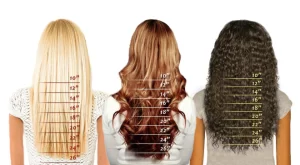There are endless possibilities for style, color, and length when it comes to hair. Choosing the right size, however, can be a daunting task. With so many options, it can be hard to determine what will look best on you, complement your face shape, and fit your lifestyle. That’s where a hair length chart comes in.
A hair length chart is a visual guide that displays different hair lengths and styles, ranging from short pixies to waist-length tresses. It can help you decide which length is right for you by providing a comprehensive overview of available options.
You can chop off your locks for a dramatic change or simply switch up your look. A hair length chart can be a valuable resource. It can help you narrow down your choices and provide inspiration for your next haircut.
In this article, we’ll explore the different hair lengths and styles for men and women. We’ll discuss choosing the correct length for your face shape, lifestyle, and personal preferences. So, let’s get started.
Table of Contents
Uses of a hair length chart
A hair length chart is valuable for anyone looking to change their hairstyle or experiment with different lengths. Here are some of its top uses of it:
1. Helps to choose the right length
A chart can help you determine which hair length will look best on you based on your face shape, hair texture, and personal style. It visually references different lengths, from short bobs to long, flowing locks.
2. May inspire you for New Hairstyles
A hair length chart can inspire you to try a new hairstyle that you may not have considered before. It showcases different styles and lengths, which can spark ideas and help you find a fresh look you love.

3. Make things easy for Your Stylist
It can be a helpful tool to bring to your hair appointment, especially if you’re unsure what length you want. It provides a clear visual representation of your desired length and style, making it easier for your stylist to understand your preferences.
4. Planning for Hair Growth
If you’re trying to grow out your hair, a chart can be a helpful tool to track your progress. It allows you to visualize the different stages of hair growth and inspires new styles to try as your hair grows longer.
5. Understanding Hair Extensions
A hair length chart can also be helpful for those interested in hair extensions. It provides a reference for different lengths and can help you choose the right length and type of extensions to achieve your desired look.
Whether you’re looking to switch up your hairstyle or simply need inspiration for a new look, a hair length chart can help you find the perfect length and style.
Hair length chart women
A hair length chart for women showcases different styles within each length category, such as layered cuts, bangs, and updos. It can be a valuable resource for anyone looking to change their hairstyle or experiment with different lengths and styles.

Curly hair length chart women
A curly hair length chart for women can be especially beneficial as this type of hair is more challenging to manage and style than straight hair. This chart can showcase different types and lengths that work well with curls, such as layered cuts that help to define curls and reduce frizz.
It can inspire those looking to embrace their natural curls or try a new curly hairstyle. It helps you choose the right length and style that will complement your face shape and personal style while working well with your unique curls.

Hair length terms
Stylists use different terms to determine the length of the hair. It’s good to be familiarized with these terms before you go for a haircut. It will help you to make them understand your requirements better.
1. Ear-Length
Hair that touches the earlobe or goes up to the top of the ear is considered ear-length. For those who want a bold look, cropped hair above the ear or higher is a great option. Short hairstyles like buzz or pixie cuts also work well with ear-length hair.
2. Chin-Length
It is when your hair reaches the level of your chin, also known as short. Layered chin-length hair is an excellent option for those seeking a sophisticated look.
3. Shoulder- Length
Shoulder-length hair is considered medium-length hair, and it typically reaches the shoulders. This hair type is an excellent compromise for those who want longer hair without weight. It works well for a ponytail, chignon, and all sorts of updos, and it also looks great worn straight down.
4. Armpit-length
It extends to the armpits and is categorized as medium-long. This is a desirable length for many women and looks glamorous when worn in loose waves, deep layers, or a high ponytail.
5. Medium-back length
They are categorized as having very long hair! This hair length looks classy when left free in curls or tied up in a bun.

The process of correctly measuring hairs of different textures
Furthermore, hair type can be classified into different types depending on the texture, including Straight, Wavy, or Curly. Here’s how you distinguish them.
1. Straight Hair
Straight hair is characterized by its ability to hang down without coiled or folded parts. This means that when measuring the length of straight hair, it appears at its actual size without any modifications. For instance, 18 inches of straight hair will fall to the level of your armpit, as opposed to the same length of wavy or curly hair.
2. Wavy Hair
Wavy hair appears slightly shorter than its actual length due to the waves. As a result, wavy hair that measures 18 inches long will fall above the armpit level – somewhere between the shoulder and the armpit. This is because the waves create folds and coils in the hair, which cause it to appear shorter than its actual length.
3. Curly Hair
Curly hair presents a further challenge when it comes to length measurement. Due to the coils throughout curly hair, it will appear even shorter than wavy hair, and the curlier the hair, the faster it will be.
For instance, if you have 18 inches of curly hair, it will fall on your shoulder. This is because the curls create even more folds and coils in the hair, causing it to appear much shorter than its actual length. Therefore, when choosing a hairstyle or considering hair length, it’s essential to remember your hair type’s unique characteristics, whether straight, wavy, or curly.
Hair length chart men
Like women, a hair length chart in inches provides a visual reference for hair length measurements. It outlines the categories of hair, such as short, medium, and long. Some online charts also include illustrations of famous men’s hairstyles for each length category, inspiring those looking to switch up their looks.

Pros and cons of using a hair length chart
Here are some positive and negative effects of using the chart.
Pros
- Help you communicate exactly how much hair you want to be cut off. You can quickly point to your desired length and avoid miscommunication with your hairstylist.
- Helps you choose a style that suits your face shape, hair texture, and lifestyle. You can browse through different lengths and styles and choose the one that best fits your preferences.
- You can quickly determine the length you want, reducing the time it takes to explain your desired haircut to your stylist.
- If you frequently get haircuts, using a chart can ensure that you get the same length each time, even if you see a different stylist.
- It can help prevent mistakes, ensure you get the haircut you want, and avoid regrets.
Cons
- Charts often have limited options, making it challenging to find the exact length and style you want.
- Hair texture can significantly impact a style’s appearance; a hair length chart doesn’t consider that. When choosing a style, please consider your hair’s texture as straight, wavy, or curly.
- Relying solely on a hair length chart can be restrictive and limit your hairstylist’s creativity. It’s essential to communicate your desired length and be open to suggestions and ideas from your stylist.
- A hair length chart may not consider your face shape, which can greatly impact how a style looks on you. It’s essential to consider your face shape when choosing a type.
- There is still a possibility of miscommunication between you and your stylist, even with a hair length chart.
Frequently Asked Questions (FAQs)
1. What is a hair length chart?
It is a visual guide that provides measurements and categories for different hair lengths. It’s typically used as a reference for hairstylists and individuals who want to accurately communicate their desired hair length.
2. How do I measure my hair length?
Start from the tip of your hair and measure straight down to the roots. Use a measuring tape or ruler and take note of the measurement in inches or centimeters.
3. What are the different hair length categories?
The specific hair length categories are short, medium, and long. Short hair typically ranges from ear-length to chin-length, medium hair ranges from shoulder-length to armpit length, and long hair is beyond armpit length.
4. Can I use a hair length chart for any hair type?
Yes, a chart can be used for any hair type, whether straight, wavy, curly, or coily. However, remember that different hair types may have varying measurements for the same length category.
5. How do I choose the right hair length for me?
The right hair length depends on your face shape, hair type, and personal style. Consulting with a hairstylist and using a hair length chart as a reference can help you determine your best hair length.
6. Can I use a hair length chart to choose a specific hairstyle?
Yes, it can inspire different hairstyles suitable for your hair length category. However, remember that other factors, such as your face shape and hair texture, may influence which hairstyles suit you best.
7. Can I use a hair length chart for facial hair?
Yes, a chart can be used as a reference for facial hair lengths, such as beard or mustache length. Some charts may include specific categories for facial hair, while others may provide general length categories that can be applied to both head and facial hair.
Final Thoughts
A hair length chart inches can be a helpful tool in choosing the right length and style for your haircut. It provides a visual reference, saves time, and can ensure consistency.
However, remember that a hair length chart has limitations and may not account for factors such as hair texture and face shape. Communicating your desired length and style with your hairstylist and being open to their suggestions and expertise is essential.
Ultimately, the key to a successful haircut is open communication, trust, and a clear understanding of your desired outcome. The benefits outweigh the losses, so we recommend you use a chart, and you will surely notice the difference.
Please check out the FAQs! For more queries, you can leave your comment below for us to answer at the earliest.

